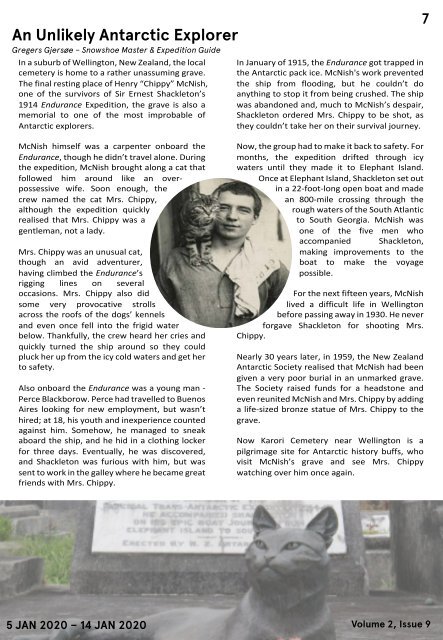V9 Antarctic Peninsula_Voyage_Log
You also want an ePaper? Increase the reach of your titles
YUMPU automatically turns print PDFs into web optimized ePapers that Google loves.
An Unlikely <strong>Antarctic</strong> Explorer<br />
Gregers Gjersøe – Snowshoe Master & Expedition Guide<br />
In a suburb of Wellington, New Zealand, the local<br />
cemetery is home to a rather unassuming grave.<br />
The final resting place of Henry “Chippy” McNish,<br />
one of the survivors of Sir Ernest Shackleton’s<br />
1914 Endurance Expedition, the grave is also a<br />
memorial to one of the most improbable of<br />
<strong>Antarctic</strong> explorers.<br />
In January of 1915, the Endurance got trapped in<br />
the <strong>Antarctic</strong> pack ice. McNish's work prevented<br />
the ship from flooding, but he couldn’t do<br />
anything to stop it from being crushed. The ship<br />
was abandoned and, much to McNish’s despair,<br />
Shackleton ordered Mrs. Chippy to be shot, as<br />
they couldn’t take her on their survival journey.<br />
7<br />
McNish himself was a carpenter onboard the<br />
Endurance, though he didn’t travel alone. During<br />
the expedition, McNish brought along a cat that<br />
followed him around like an overpossessive<br />
wife. Soon enough, the<br />
crew named the cat Mrs. Chippy,<br />
although the expedition quickly<br />
realised that Mrs. Chippy was a<br />
gentleman, not a lady.<br />
Mrs. Chippy was an unusual cat,<br />
though an avid adventurer,<br />
having climbed the Endurance’s<br />
rigging lines on several<br />
occasions. Mrs. Chippy also did<br />
some very provocative strolls<br />
across the roofs of the dogs’ kennels<br />
and even once fell into the frigid water<br />
below. Thankfully, the crew heard her cries and<br />
quickly turned the ship around so they could<br />
pluck her up from the icy cold waters and get her<br />
to safety.<br />
Also onboard the Endurance was a young man -<br />
Perce Blackborow. Perce had travelled to Buenos<br />
Aires looking for new employment, but wasn’t<br />
hired; at 18, his youth and inexperience counted<br />
against him. Somehow, he managed to sneak<br />
aboard the ship, and he hid in a clothing locker<br />
for three days. Eventually, he was discovered,<br />
and Shackleton was furious with him, but was<br />
sent to work in the galley where he became great<br />
friends with Mrs. Chippy.<br />
Now, the group had to make it back to safety. For<br />
months, the expedition drifted through icy<br />
waters until they made it to Elephant Island.<br />
Once at Elephant Island, Shackleton set out<br />
in a 22-foot-long open boat and made<br />
an 800-mile crossing through the<br />
rough waters of the South Atlantic<br />
to South Georgia. McNish was<br />
one of the five men who<br />
accompanied Shackleton,<br />
making improvements to the<br />
boat to make the voyage<br />
possible.<br />
For the next fifteen years, McNish<br />
lived a difficult life in Wellington<br />
before passing away in 1930. He never<br />
forgave Shackleton for shooting Mrs.<br />
Chippy.<br />
Nearly 30 years later, in 1959, the New Zealand<br />
<strong>Antarctic</strong> Society realised that McNish had been<br />
given a very poor burial in an unmarked grave.<br />
The Society raised funds for a headstone and<br />
even reunited McNish and Mrs. Chippy by adding<br />
a life-sized bronze statue of Mrs. Chippy to the<br />
grave.<br />
Now Karori Cemetery near Wellington is a<br />
pilgrimage site for <strong>Antarctic</strong> history buffs, who<br />
visit McNish’s grave and see Mrs. Chippy<br />
watching over him once again.<br />
5 JAN 2020 – 14 JAN 2020<br />
Volume 2, Issue 9

















